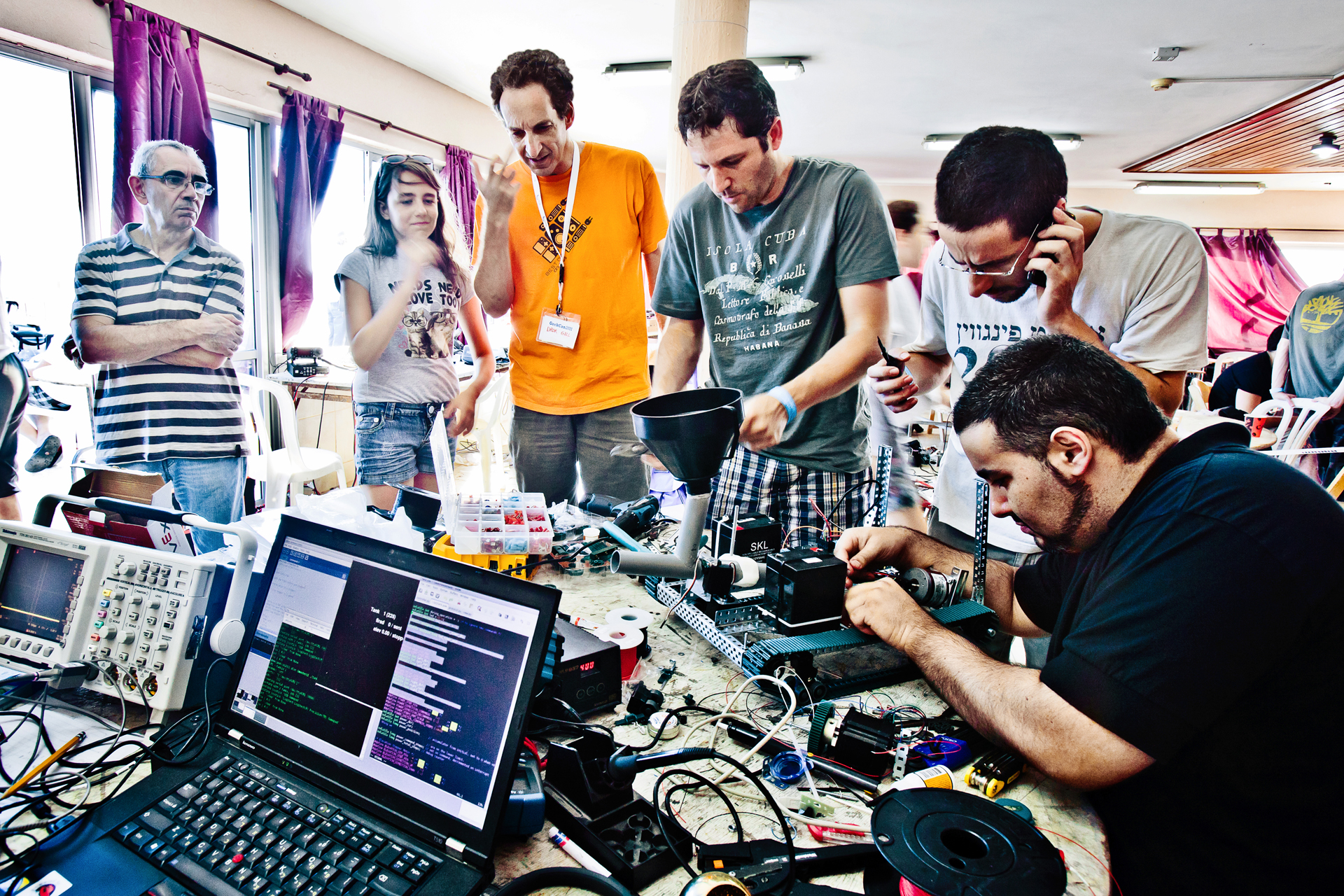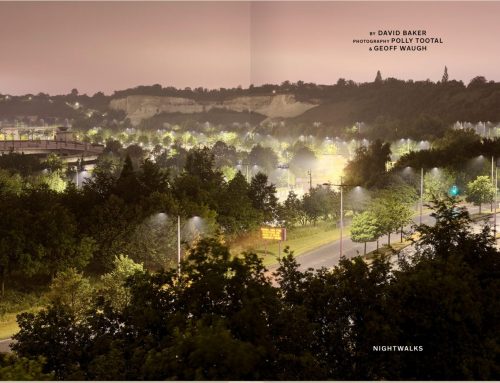Israel’s GeekCon is the irreverent tech meetup that emphasises fun and games. Wired went to join in
Wired, December 2011
In 2004, three Israeli technology entrepreneurs — Ilan Graicer, then 36, Eden Shochat, 27, and Nimrod Lehavi, 29 — left the country’s annual tech conference, Kinnernet, and decided they couldn’t wait 12 months for the next one. They set up GeekCon, a rough-and-ready maker conference that would be light on attending talks and raising capital, and big on building things. It quickly attracted a crowd of enthusiastic programmers, artists, mechanics and electrical engineers. Early projects included a wooden Enigma machine powered by a bicycle.
Seven years on, GeekCon is rather more established — this year’s sponsors were Intel, Google and Microsoft — but it has kept its homespun, slightly absurd, ethos. In September, on a former kibbutz on the coast at Caesaria, 120 delegates worked for three days on projects that included a 3D popcorn printer, a paddling pool that harnessed the Sun’s rays to cook sausages, and a choir of toy rabbits that could be “conducted” via a hacked Kinect sensor. “GeekCon projects usually don’t go to plan,” says Inbar Raz, 36, a GeekCon veteran. “Materials are missing, stuff doesn’t work. The idea is that you have to improvise, think around the side. It’s a very important skill.”
What’s popular at GeekCon is a good predictor of mainstream trends. “In 2008, it was real-time audio,” says Shochat, now 33. “In 2009 it was webcams, last year was lasers and Arduinos. In five years, we’ll probably see augmented humanity — superhuman vision, interesting implants.”
Meanwhile, GeekCon is expanding. A version for military personnel takes place at an air-force base in the desert. And next year, also in the desert, there will be an extra conference for environmental projects. “We’ll live in Bedouin tents and everything will be in short supply,” says Graicer. “Energy, food, water. People will have to find creative ways around real-life problems. There’ll be no plugging in an extra power pack if you need one.
GEEKCON’S FINEST
A toy car controlled by an Emotiv headset
Who: Nimrod Lehavi, software developer and GeekCon founder.
What: He wanted to use an Emotiv headset to drive a real car using only his thoughts. instead he wrote a program to capture the Emotiv’s outputs as keystrokes on his laptop and transmit them as commands to an arduino board connected to a toy RC car’s remote.
The challenge: The circuitry could handle forwards, backwards, left and right but he found it impossible to get the headset to distinguish four emotions. “Even making it go forwards and back was hard,” he says. But frustration came to his aid. “I thought, ‘I hate you,’ and it sped away.”
The outcome: A toy car that could be driven just by thinking.
Real-world application: Hands-free commuting, so long as you can remain focused.
A bicycle that plays music from a till roll
Who: Itamar Katz, 35, and Sophia Novosolov, 28
What: Katz marked black squares on a till roll wrapped around a bike wheel. A light sensor detected each mark and fed the data to a laptop, where it was converted into sounds.
The challenge: the “music” lasted just one second, and ambient light confused it.
The outcome: a second wheel made for more variation.
Real-world application: Make sounds as you pedal.
Wireless robots that shoot tomatoes
Who: Hovav Moseri, 36, et al
The project: A real-world homage to Scorched Earth.
The challenge: Moving them.
The outcome: A burnt-out circuit board prevented any play at all.
Real-world application: Drones for video-game generation.
A self-adjusting weather balloon
Who: Yariv Bash, 31; Shachar Tal, 34; Omri Shacham, 33; electrical engineer and programmers.
What: Helium weather balloons, which carry monitoring equipment, reaching altitudes of about 40km before bursting. Bash, tal and Shacham built a balloon that could self-adjust its altitude to between 20km and 30km to stay up as long as possible. An on-board gps fed altitude data to two arduino-controlled motors, which controlled valves on the balloon itself and on a tank of liquid ballast. (the ballast was pure alcohol, which remains liquid even at -60°C.) Releasing gas caused the balloon to descend; shedding ballast made it rise.
The challenge: The valves opened too slowly. “We needed to be able to release about 80m3 of gas in two hours,” says Shacham.
The outcome: With new valves and code, the balloon flew just 40 metres. Later it stayed up for three days and came down somewhere in the Indian Ocean.
Real-world application: a long-range spy balloon, barely detectable by radar.
An Android crossbow
Who: Udi Cohen, 30; Dror Shimoni, 30; programmers
What: Cohen and Shimoni wanted to do something with their hands, so they brought wood to build a crossbow from scratch. Two DIY drills controlled by an Arduino turned to adjust the crossbow’s elevation and bearing. The smart- phone’s camera located the target and used its internal compass to calculate the aim co-ordinates. This data was sent wirelessly to the arduino board, which aimed the crossbow and fired.
The challenge: “It was fun for two software guys to be working in wood,” says Cohen. “But, to begin with, it was hard to get the bolt to hit the target even without the smartphone.”
The outcome: a direct hit after about 30 tries.
Real-world application: Smartphones in a soldier’s kit.
A swarm of miniature strandbeests
Who: Eldad Galker, 49; Liol Goldstein, 20; Gabriel Paciornik, 33.
What: Theo Janssen’s metres- long Strandbeest sculptures use the wind to “walk” on articulated legs across the beaches. Galker wanted to design tiny, balsa-wood versions. The problem: the legs wouldn’t move, even in a strong wind. “In metres there is quite a lot of tolerance,” says Galker. “Scale that down by a factor of 100 and you have serious difficulties.”
The outcome: Galker’s team produced multicoloured iterations “ready for the next stage”.
Real-world application: Kinetic art replacing sandcastles.
A beer cooler you play like an instrument
Who: Inon Rettig, 30; Dana Ben Nissan, 27, Arthur Brutter, 29; Oren Hetzroni, 28; Alon Hetzroni, 25; Jasmine Florentine, 22.
What: the team installed an ultrasonic sensor on the cooler’s top to detect hand movements. A five-pole switch was activated by rotating the lid. Data from each of these was fed back to a laptop and turned into music.
The challenge: “the lids got stuck. We also needed to find some nice chords that the sensors could play,” says Ben Nissan.
The outcome: With “tuning”, an addictive musical instrument.
Real-world application: impromptu jamming in summer.






